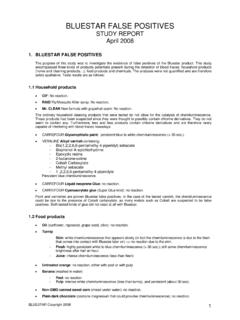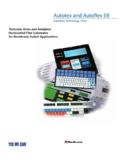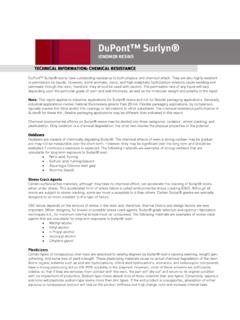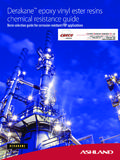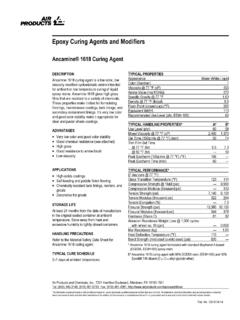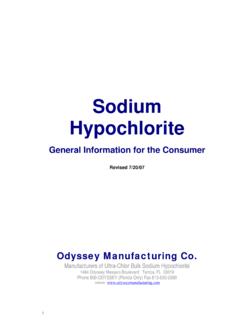Transcription of Use of Bluestar Forensic in Lieu of Luminol at Crime …
1 Journal of Forensic Identification706 / 56 (5), 2006 Technical NoteUse of Bluestar Forensic in lieu of Luminol at Crime ScenesLisa DilbeckScottsdale Police Department Scottsdale, AZAbstract: Bluestar Forensic , a new Luminol -based reagent, was tested in a blood-detection comparison study against Luminol . Photographic results were compared and the ease of preparation and the lack of the need for complete darkness for visualization were evaluated. This study determined that Bluestar Forensic has distinct advantages when compared to Luminol . IntroductionFor many years, chemiluminescence has been used to detect trace amounts of blood at Crime scenes. One popular chemiluminescence product has the generic name of Luminol . Luminol is effective in the detection of old, hard-to-see, cleaned-up blood. Luminol has enabled investigators to detect, evaluate, and collect blood not visible to the naked eye. However, some aspects of Luminol make its use challenging: It requires almost complete darkness to visualize and photograph.
2 Repeated or constant spraying of Luminol increases the amount of fading of the chemiluminescence, and excessive application can create streaking on vertical surfaces and pooling on horizontal surfaces. Luminol must be mixed close to the time of the spraying. Luminol is considered to be a possible carcinogen and requires appropriate personal protective equipment. The process of preparing Luminol requires a knowledge of chemistry. Received September 15, 2005; accepted October 14, 2005 Journal of Forensic Identification56 (5), 2006 \ 707A new product, Bluestar Forensic1, is now available as a substitute for Luminol . Although Bluestar Forensic is Luminol -based and functions in the same way as Luminol , its properties make it more convenient for Crime scene investigations: It does not require complete darkness, it maintains the same chemiluminescence after each spray, it can be used up to several days after mixing, and it does not require a knowledge of chemistry [1] (Table 1).
3 Most important for investigators is that Bluestar Forensic is convenient to prepare. The purpose of this experiment was to determine whether Bluestar Forensic is a better choice than Luminol for use at Crime scenes. LuminolBluestar ForensicNeeds almost complete darknessDoes not need complete darknessDiminished luminescence during second applicationMaintains same luminescence during a second applicationLaboratory preparation is necessaryEasy to mix in the fieldNo shelf life after mixingCan be used for several days after mixingNot destructive to DNA Not destructive to DNA Table 1 Comparison of Luminol and Bluestar 1928, a chemist named Albrecht discovered a chemical that, when placed in an alkaline solution with hydrogen peroxide and a catalyst, would emit an intense blue light, with no heat expelled. This chemical was a precursor to the modern Luminol . In 1937, a scientist named Specht used Albrecht s chemical to test a variety of blood-soaked items. In 1951, Grodsky used Albrecht s chemical with sodium carbonate, sodium perborate, and distilled water to detect trace amounts of blood.
4 Grodsky s formula was found to be unstable with the addition of sodium perborate. An improvement on Grodsky s formula was made by Weber (1966), who replaced the sodium perborate with hydrogen peroxide [1]. Weber s formula is in use by police departments today. Luminol is most commonly made by using sodium carbonate, hydrogen 1 Bluestar Forensic is a product of ROC Import Group, 16 Avenue de la Costa, 246, Monte Carlo, 98005 of Forensic Identification708 / 56 (5), 2006peroxide, 3-Aminophthalhydrazide, and distilled water. In 2000, Dr. Loic Blum (University of Claude Bernard-Lyon) devised a new Luminol -based formula, which was later named Bluestar Forensic [1]. Although Bluestar Forensic is Luminol -based, it is a patented formula and is unavailable for publication [2]. Luminol s action (chemiluminescence) should not be confused with fluorescence. Chemiluminescence requires a catalyst. In the case of Luminol , this can be the iron in hemoglobin. Luminol for use in police work is generally bought premade and is then mixed with sodium carbonate and hydrogen peroxide.
5 A disadvantage of Luminol is that it can produce false positives when it is used on strong oxidants, some metal ions, and peroxidases. This means that luminescence, although less pronounced, can be seen when Luminol is sprayed on copper (or any alloy), bleaches, and horseradish [3]. To overcome this limitation and to help reduce the interference of bleach upon the Luminol , it is best to allow the bloodstains to dry thoroughly (giving bleach time to decompose) [3]. Bluestar Forensic was originally produced for hunters. The blood-revealing agent is used to help locate wounded animals. The Bluestar Forensic used for hunters has a pH of and therefore is unsuitable for DNA processing of blood. ROC Import Group made Bluestar Forensic for police work to have a pH of Because of the adjusted pH, Bluestar Forensic is suitable for DNA STR typing [2]. It has long been known that Luminol does not affect the PCR or STR process [4, 5, 6]. Bluestar Forensic does not show DNA degradation, and successful DNA typing has been accomplished up to thirty days after application of Bluestar Forensic [1].
6 However, for this experiment the focus was on the ease of use of the chemical and not its ability to type DNA; therefore, a mixture of human and equine blood was used and was not typed. For the purpose of this experiment, shelf life, use after preparation, and DNA were not and MaterialsTesting Materials Six pairs of testing materials were made three months in advance of the actual tests. The first four sets of test surfaces (maple wood, Olefin carpet, vinyl tile, and ceramic tile) were setup in the same manner. Journal of Forensic Identification56 (5), 2006 \ 709A plastic pipet was used to put impact blood stains on four samples of each test surface. The blood was allowed to dry for 12 days. The blood was then removed from two samples of each test surface with a cellulose sponge that had been soaked in tap water. The blood from the other two test surfaces was removed with a cellulose sponge that had been soaked in tap water containing bleach, hereafter referred to as bleach. The samples were grouped to provide two samples of each surface (one washed with water and one washed with bleach) for each treatment to be tested ( Luminol and Bluestar Forensic ).
7 The fifth surface was a new blue 100% cotton T-shirt. A shoeprint in blood was put on the front and back sides of the T-shirt. The stains were allowed to dry for 12 days. The T-shirt was then laundered using Purex laundry detergent in a warm/cold wash cycle for 30 minutes. The T-shirt tumble dried for 60 minutes. One side of the T-shirt was to be treated with Luminol and the other was to be treated with Bluestar Forensic . The final surface was a new dark blue CoolMax (polyester) shirt. A shoeprint in blood was put on the front and back sides of the shirt. The stains were allowed to dry for 8 minutes and then the shirt was placed under cold running tap water. The shirt was allowed to dry for 12 days. The shirt was then laundered using Purex laundry detergent in a warm/cold wash cycle for 30 minutes. The shirt was tumble dried for 60 minutes. One side of the T-shirt was to be treated with Luminol and the other was to be treated with Bluestar Forensic . As a control sample, two vinyl sheets were smeared with water containing bleach.
8 Chemical PreparationThe Luminol was prepared according to Scottsdale Police Department s Crime Lab protocol. Ten grams of sodium carbonate and g of premixed Luminol were mixed with 180 mL of distilled water in a 1000 mL beaker, and then 180 mL of 3% hydrogen peroxide was added. After hand mixing, the solution was then placed into a spray Bluestar Forensic was prepared according to the manufacturer s instructions. Two Bluestar Forensic tablets (one beige and one white tablet) were taken from their sealed pouches Journal of Forensic Identification710 / 56 (5), 2006and were added to 175 mL of distilled water in a spray bottle. The spray bottle was closed and the nozzle of the spray was opened for ventilation. The solution was stirred gently by rocking the bottle for approximately 5 minutes until dissolution was application of the Luminol and Bluestar Forensic was the same. The contents of the spray bottles were sprayed in a sweeping motion on each test sample at a distance of 15 to 18 inches from the object.
9 PhotographyThe results were photographed using standard fluorescent photography techniques [7, 8]. All photographs were taken with a Fuji S3 Pro Digital Camera, using an ISO sensitivity rating of 400. Trial exposures were taken prior to the experiment to establish optimum exposure settings. The experiment was conducted in a laboratory environment with dim lights during the Bluestar Forensic tests and a darker (approximately one stop difference) environment for the Luminol . The aperture was set at for all of the photographs. The timed-exposure photographs varied slightly with the initial treatment on the six test surfaces (wood, carpet, vinyl tile, ceramic tile, T-shirt, plastic sheet) ( , 3 seconds for the Bluestar Forensic and 4 seconds for the Luminol ). The timed-exposure for those surfaces during the second treatment was the same for the Bluestar Forensic and the Luminol ( , 4 seconds). The timed-exposure photographs for the initial treatment on the CoolMax shirt was extended to 8 seconds for the Bluestar Forensic and 30 seconds for the Luminol .
10 No exposures were made during the second of Forensic Identification56 (5), 2006 \ 711 Results and DiscussionThe results of these experiments are shown in Table 2 and Figures 1 - 12. In all cases, Bluestar Forensic outperformed Luminol . The carpet showed the best results for both reagents, most likely because the carpet had the best visual bloodstains prior to staining. The vinyl tile and the ceramic tile also showed strong reactions. The most obvious difference between the reagents on these surfaces was the strength of the chemiluminescence in the second spray of the Bluestar Forensic . The majority of the reactions took place in the areas where the blood had been cleaned with only water. It appeared that the bleach removed any traces of the blood from the majority of the surfaces. It was surprising to note that besides the carpet, no false positives were noted between the reagents and the bleach. Both reagents are known to react with materials in bleach. The only reaction to the bleach-cleaned areas was with the carpet; however, no difference in color or intensity could be determined between the water and the bleach areas.




